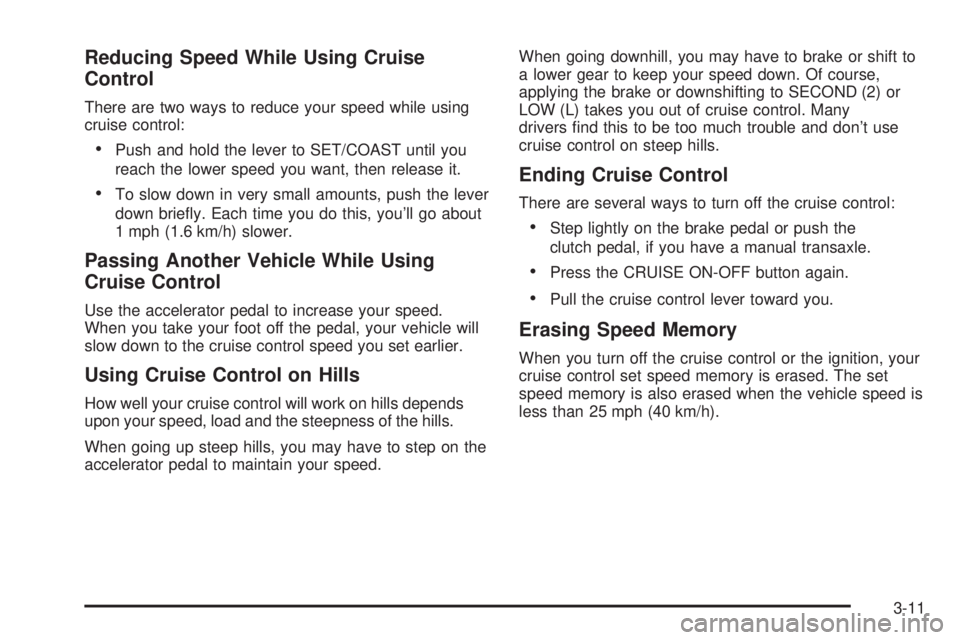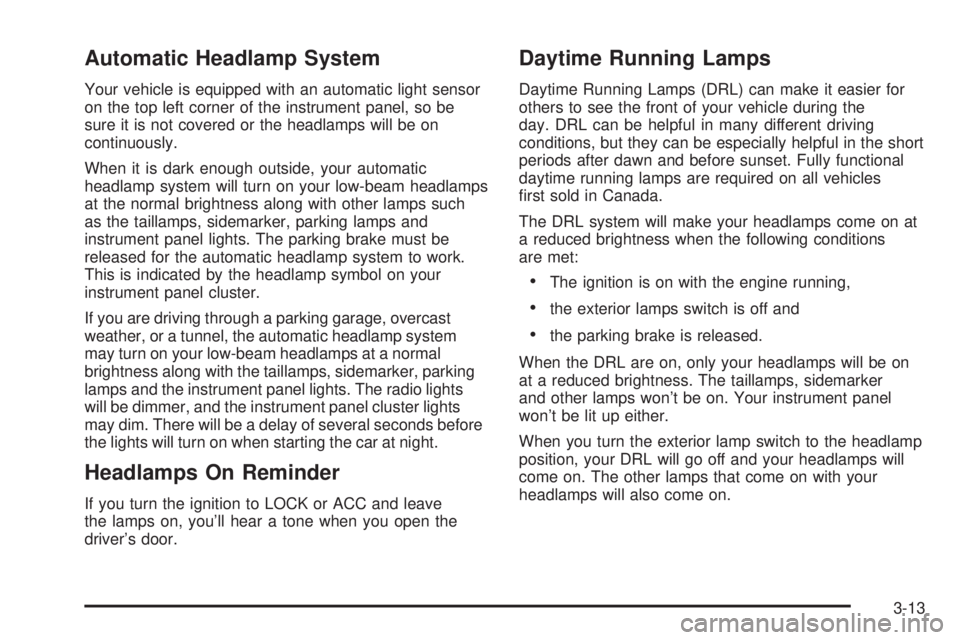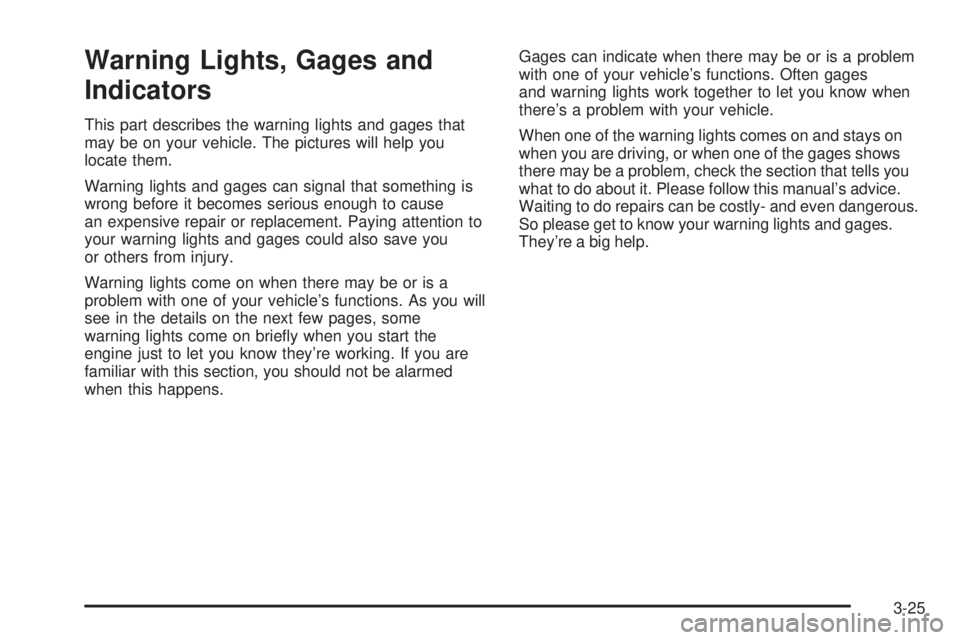light PONTIAC VIBE 2004 Owner's Manual
[x] Cancel search | Manufacturer: PONTIAC, Model Year: 2004, Model line: VIBE, Model: PONTIAC VIBE 2004Pages: 370, PDF Size: 2.68 MB
Page 117 of 370

Reducing Speed While Using Cruise
Control
There are two ways to reduce your speed while using
cruise control:
·Push and hold the lever to SET/COAST until you
reach the lower speed you want, then release it.
·To slow down in very small amounts, push the lever
down brie¯y. Each time you do this, you'll go about
1 mph (1.6 km/h) slower.
Passing Another Vehicle While Using
Cruise Control
Use the accelerator pedal to increase your speed.
When you take your foot off the pedal, your vehicle will
slow down to the cruise control speed you set earlier.
Using Cruise Control on Hills
How well your cruise control will work on hills depends
upon your speed, load and the steepness of the hills.
When going up steep hills, you may have to step on the
accelerator pedal to maintain your speed.When going downhill, you may have to brake or shift to
a lower gear to keep your speed down. Of course,
applying the brake or downshifting to SECOND (2) or
LOW (L) takes you out of cruise control. Many
drivers ®nd this to be too much trouble and don't use
cruise control on steep hills.
Ending Cruise Control
There are several ways to turn off the cruise control:
·Step lightly on the brake pedal or push the
clutch pedal, if you have a manual transaxle.
·Press the CRUISE ON-OFF button again.
·Pull the cruise control lever toward you.
Erasing Speed Memory
When you turn off the cruise control or the ignition, your
cruise control set speed memory is erased. The set
speed memory is also erased when the vehicle speed is
less than 25 mph (40 km/h).
3-11
Page 118 of 370

Exterior Lamps
The lever on the left side of the steering column
operates the exterior lamps.
O(Exterior Lamps):Turn the outside part of the
lever with the symbol on it, to operate the lamps.The exterior lamp switch has three positions:
OFF:Turning the switch to this position turns off all
lamps, except the Daytime Running Lamps (DRL).
O(Parking Lamps):Turning the switch to this position
turns on the parking lamps together with the following:
·Sidemarker Lamps
·Taillamps
·License Plate Lamp
·Instrument Panel Lights
3(Headlamps):Turning the switch to this position
turns on the headlamps, together with the previously
listed lamps and lights.
Turn the switch to OFF to turn off the lamps.
-(Fog Lamps):You can also use the control lever
to turn on the fog lamps. They will come on only
when the headlamps are on low beam.
3-12
Page 119 of 370

Automatic Headlamp System
Your vehicle is equipped with an automatic light sensor
on the top left corner of the instrument panel, so be
sure it is not covered or the headlamps will be on
continuously.
When it is dark enough outside, your automatic
headlamp system will turn on your low-beam headlamps
at the normal brightness along with other lamps such
as the taillamps, sidemarker, parking lamps and
instrument panel lights. The parking brake must be
released for the automatic headlamp system to work.
This is indicated by the headlamp symbol on your
instrument panel cluster.
If you are driving through a parking garage, overcast
weather, or a tunnel, the automatic headlamp system
may turn on your low-beam headlamps at a normal
brightness along with the taillamps, sidemarker, parking
lamps and the instrument panel lights. The radio lights
will be dimmer, and the instrument panel cluster lights
may dim. There will be a delay of several seconds before
the lights will turn on when starting the car at night.
Headlamps On Reminder
If you turn the ignition to LOCK or ACC and leave
the lamps on, you'll hear a tone when you open the
driver's door.
Daytime Running Lamps
Daytime Running Lamps (DRL) can make it easier for
others to see the front of your vehicle during the
day. DRL can be helpful in many different driving
conditions, but they can be especially helpful in the short
periods after dawn and before sunset. Fully functional
daytime running lamps are required on all vehicles
®rst sold in Canada.
The DRL system will make your headlamps come on at
a reduced brightness when the following conditions
are met:
·The ignition is on with the engine running,
·the exterior lamps switch is off and
·the parking brake is released.
When the DRL are on, only your headlamps will be on
at a reduced brightness. The taillamps, sidemarker
and other lamps won't be on. Your instrument panel
won't be lit up either.
When you turn the exterior lamp switch to the headlamp
position, your DRL will go off and your headlamps will
come on. The other lamps that come on with your
headlamps will also come on.
3-13
Page 121 of 370

The brightness of the instrument panel lights will
decrease when the headlamps are on. It is recommended
that the brightness level is kept at the maximum setting
for all daytime driving to insure proper visibility.
The interior light has the following positions:
OFF:This position turns the light off.
ON:This position keeps the light on all the time.
6(Door):This position turns the light on when any
of the side doors, the liftgate or the liftglass is opened.
The light goes off when all the side doors, the liftgate
and the liftglass are closed.
Entry Lighting
While the instrument panel brightness control is in the
door position, the light will come on when any side door,
the liftgate or the liftglass is opened. After all the side
doors, liftgate and liftglass are closed, and the key is out
of the ignition, in LOCK or ACC, the light will remain
on for about 15 seconds and then go out except under
the following conditions:
·The ignition is turned to ACC or ON after all the side
doors, the liftgate and the liftglass are closed.
·All the side doors and liftgate are locked when the
liftglass is closed and the light is still on.
When any side door is unlocked with the key or remote
keyless entry system transmitter, the light comes on
for 15 seconds, even if the door is not opened.
To prevent the battery from draining, the lamps
will automatically turn off when the key is in the
ACC or LOCK positions or if the key is removed
for 20 minutes or more.
3-15
Page 122 of 370

Reading Lamp
If you have a sunroof, you will have a reading lamp
near the sunroof switch. Press the button to turn
the lamp on and press it again to turn it off.If you do not have a sunroof, your vehicle's inside
rearview mirror may be equipped with reading lamps.
If your vehicle is equipped with reading lamps, there are
two buttons located on the bottom of the mirror. Press
the buttons to turn the lamps on and press them again to
turn the lamps off.
To prevent the battery from draining, the lamps will
automatically turn off when the key is in the ACC
or LOCK positions or if the key is removed for 20
minutes or more. The lights will come on when any of
the doors are opened or if the key is turned to the
ON position.
3-16
Page 124 of 370

Power Outlet 115 Volt Alternating
Current
With this power outlet, you can plug in auxiliary electrical
equipment with a maximum limit of 115 VAC. If you
try to use equipment that requires more than the limit, a
protection circuit will cut the power supply. The power
will automatically restart when equipment that operates
within the limit is plugged in.The power outlet is located near the center of the
instrument panel. Before using the outlet, turn on the
ignition and press the button next to the outlet.
An indicator light in the button will come on. After using
the outlet, press the button again to turn it off.
The power outlet is not designed for the following
electrical equipment and they may not work properly:
·Equipment with high initial peak wattage:
cathode-ray tube type televisions,
compressor-driven refrigerators, electric
power tools.
·Other equipment requiring an extremely stable
power supply: microcomputer-controlled electric
blankets, touch sensor lamps, etc.
3-18
Page 125 of 370

Ashtrays and Cigarette Lighter
Notice:Don't put papers or other ¯ammable items
into your ashtrays. Hot cigarettes or other smoking
materials could ignite them, causing a damaging ®re.
To use the lighter, push the lighter in all the way
and let go. When it's ready, it will pop back
out by itself. If the engine is not running, the key
must be in ACC to use the lighter.
It is not recommended to use the cigarette lighter to
plug in auxiliary electrical equipment. Use the accessory
power outlet for phones and other electrical equipment.
See
Accessory Power Outlets on page 3-17orPower
Outlet 115 Volt Alternating Current on page 3-18.
Notice:Don't hold a cigarette lighter in with your
hand while it is heating. If you do, it won't be able to
back away from the heating element when it's
ready. That can make it overheat, damaging the
lighter and the heating element.
Your vehicle has a removable ashtray that sits in your
front cupholder in the center console storage area.
Climate Controls
Climate Control System
With this system you can control the heating, cooling
and ventilation for your vehicle.
Operation
9
(Fan):Turn the center knob away from OFF to turn
the system on. Turn the knob toward HI to increase
fan speed.
If the air¯ow seems low when the fan is at the highest
setting, the passenger compartment air ®lter may
need to be replaced. For more information, see
Passenger Compartment Air Filter on page 3-23andShort Trip/City Scheduled Maintenance on page 6-7.
3-19
Page 126 of 370

To change the current mode, select one of the following:
H(Vent):This mode directs air to the upper
instrument panel outlets.
)(Bi-Level):This mode directs the air to the upper
instrument panel outlets, and to the ¯oor outlets.
6(Floor):This mode directs the air to the ¯oor outlets
and to the outboard outlets (for the side windows).
?(Recirculation):This mode keeps outside
air from coming in the vehicle. It can be used to prevent
outside air and odors from entering your vehicle or to
help heat or cool the air inside your vehicle more quickly.
Press this button, located in the center of the instrument
panel to the left of the audio system, to turn the
recirculation mode on or off. When the button is pressed,
an indicator light in the button will come on. Press the
button again to turn off recirculate and to circulate
outside air through the system. The indicator light will
go off. Recirculate is automatically turned off when
the climate control system mode knob is turned to defog
or defrost or is between modes.
Temperature Control:Turn the right knob clockwise or
counterclockwise to increase or decrease the
temperature inside your vehicle.A/C (Air Conditioning):Press this button, located in
the center of the instrument panel to the left of the audio
system, to turn the air-conditioning system on or off.
When A/C is pressed, an indicator light in the button will
come on to let you know that the air conditioning is
activated.
On hot days, open the windows to let hot inside air
escape; then close them. This helps to reduce the time
it takes for your vehicle to cool down. It also helps
the system to operate more efficiently.
For quick cool down on hot days:
1. Select the vent mode.
2. Select the recirculation mode.
3. Select A/C.
4. Select the coolest temperature.
5. Select the highest fan speed.
The air-conditioning system removes moisture from the
air, so you may sometimes notice a small amount of
water dripping underneath your vehicle while idling
or after turning off the engine. This is normal.
3-20
Page 127 of 370

Defogging and Defrosting
Fog on the inside of windows is a result of high humidity
(moisture) condensing on the cool window glass. This
can be minimized if the climate control system is
used properly. There are two modes to clear fog or frost
from your windshield. Use the defog mode to clear
the windows of fog or moisture and warm the
passengers. Use the defrost mode to remove fog or
frost from the windshield more quickly.
-(Defog):This mode directs the air between the
windshield, side windows, instrument panel outlets and
the ¯oor outlets. The air-conditioning compressor
will run automatically in this setting without pressing
A/C, unless the outside temperature is at or below
freezing.
1(Defrost):This mode directs the air to the
windshield, instrument panel outlets and the side
windows. The air-conditioning compressor will run
automatically in this setting without pressing A/C, unless
the outside temperature is at or below freezing.
Do not drive the vehicle until all the windows are clear.
Rear Window Defogger
The rear window defogger uses a warming grid to clear
fog from the rear window.
The rear window defogger
button is located on the
center of the instrument
panel, above the audio
system. The defogger does
not operate with the rear
liftglass opened.
The rear window defogger will only work when the
ignition is in ON.
=(Rear Defogger):Press the defogger button to turn
the rear window defogger on or off. An indicator light
in the button will come on to let your know that the rear
window defogger is activated. Be sure to clear as
much snow from the rear window as possible.
3-21
Page 131 of 370

Warning Lights, Gages and
Indicators
This part describes the warning lights and gages that
may be on your vehicle. The pictures will help you
locate them.
Warning lights and gages can signal that something is
wrong before it becomes serious enough to cause
an expensive repair or replacement. Paying attention to
your warning lights and gages could also save you
or others from injury.
Warning lights come on when there may be or is a
problem with one of your vehicle's functions. As you will
see in the details on the next few pages, some
warning lights come on brie¯y when you start the
engine just to let you know they're working. If you are
familiar with this section, you should not be alarmed
when this happens.Gages can indicate when there may be or is a problem
with one of your vehicle's functions. Often gages
and warning lights work together to let you know when
there's a problem with your vehicle.
When one of the warning lights comes on and stays on
when you are driving, or when one of the gages shows
there may be a problem, check the section that tells you
what to do about it. Please follow this manual's advice.
Waiting to do repairs can be costly- and even dangerous.
So please get to know your warning lights and gages.
They're a big help.
3-25